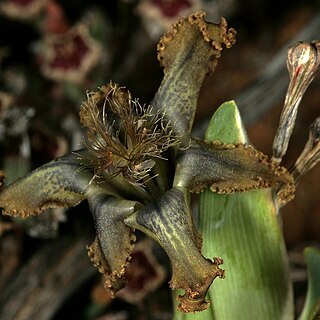Plants usually robust, up to 500 mm high; stem much branched in upper half, sheathed by leaf bases below. Leaves several, linear to sword-shaped, 6-12 mm wide, basal leaves longest with visible main vein. Inflorescences 2-flowered rhipidia; spathes green with membranous margins. Flowers on pedicels 40-60 mm long, lasting a single day, pale yellow to beige with brown to dull purple mottling, strongly scented; tepals widely divergent forming a shallow bowl, limbs spreading horizontally; outer tepals 28-35 mm long, inner tepals slightly shorter and narrower. Ovary spindle-shaped, not beaked; style branches forked in upper half with diverging arms 4-5 mm long prominently fringed; stigmas terminal on style arms. Flowering time Aug.-Oct. Capsule 15-25 mm long, ovoid to oblong. Seeds angular, 5-sided, ± 4 mm long, facets wrinkled.
Cormous geophyte, 60-200 mm tall, often branching close to base. Leaves sword-shaped, crowded basally, without a midrib, margins often lightly thickened, sheaths concealing stem. Flowers dull yellow, yellow-green or light brown, with banded or speckled markings and darker margins, often putrid smelling, claws broad, forming a wide cup, nectaries usually dark, basal, or occasionally large pouches in middle of outer tepal claws, anther lobes diverging. Capsule beaked.
Cormous geophyte, 6-20 cm, branching mostly near base. Leaves sword-shaped, crowded at base, sheathing the stem. Flowers dull yellow, yellow-green or brown, with banded or speckled markings and darker margins, often putrid-smelling, claws broad, forming a wide cup, nectaries usually basal, dark-coloured, anther lobes diverging, capsules beaked.

